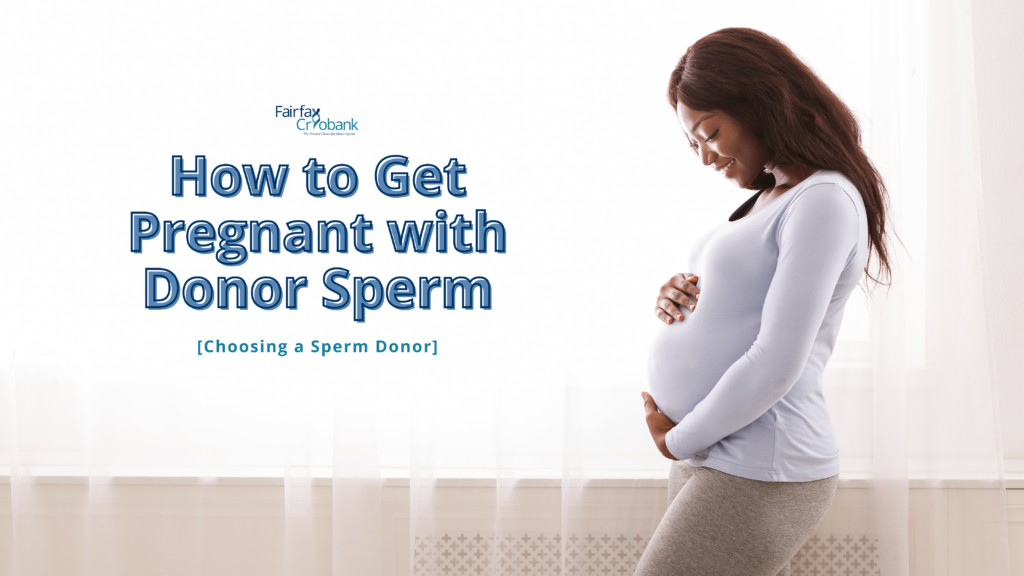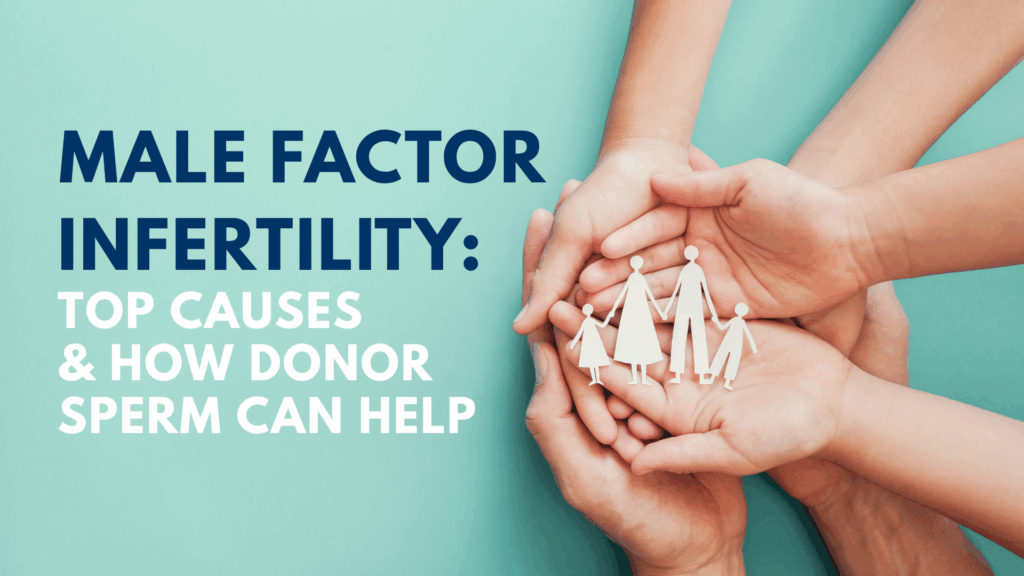How to Get Pregnant with Donor Sperm #3: Choosing a Sperm Donor
Get advice on how to pick the perfect sperm donor for you and your growing family

We have reached the finish line of the 3-part series on how to get pregnant with donor sperm. After covering preconception exams, and how to live a healthier lifestyle to have a safe and pregnancy. We will finally be diving into choosing the perfect sperm donor for you and your growing family. If you missed part 1 or part 2 view them here:
How to Get Pregnant with Donor Sperm #1: Preconception Exams
How to Get Pregnant with Donor Sperm #2: Making Changes for a Healthy Lifestyle
Choosing a sperm donor is such an exciting experience for new families. From using Fairfax Cryobank’s search options for the first time, to looking through a sperm donor’s adorable childhood photos, and listening to a sperm donor’s audio interview, it can be overwhelming. But where do you start? How do you know if a certain sperm donor is right for you and your growing family? Read on to find the answers to these questions and much more.
Step 1 – Donor Search Options
Here at Fairfax Cryobank, we strive to provide all our families as many options as possible to find your perfect sperm donor match. As you enter the Fairfax Donor Search, you will see options for eye color, height, hair color, and even education level. The options might seem endless! With the help of Pacific Reproductive Services RN, Kate Wisda, we’ll be covering some donor search options that you didn’t even know were important to your search.
Genetic Testing Search Options
- Expanded Genetic Disease Tested Donors – Picking a donor with an Expanded Genetic Panel means your donor has been tested for hundreds of different genetic disorders. This testing can
- Select by Genetic Disease(s) Tested Negative or Select by Gene(s) Tested Negative – If you have tested positive for a specific recessive genetic disorder, find a donor that tests negative to prevent disease in your offspring. Search by the gene name (and exact subtype) or the name of the disorder to find a negative donor.
negative donor.
Advanced Search Options
When using the Advanced Search option on Fairfax’s donor search you will have the opportunity to customize your search with categories like ethnic background, blood type, RH factor, CMV Status and, much more.
- Donor Brand – add a blurb about Fairfax/PRS/CLI
- Positive Pregnancy – add a blurb for this filter too
- CMV Status – This allows you to search for a donor that is + or – for past exposure to Cytomegalovirus (CMV).
- Blood Type and RH Factor – This allows you to search for a donor with a blood type that is compatible with yours.
Why does CMV Status Matter?
Cytomegalovirus (CMV) is a common virus in the same family as chickenpox and cold sores. Infected people can experience mild cold- or flu-like symptoms for one to two weeks. Some infected individuals have no detectable symptoms. Following infection, most individuals gain immunity from the virus.
Between 50 and 85 percent of American adults have been exposed to CMV, with the majority of cases occurring in childhood – these individuals will test CMV positive for exposure (antibodies). If a donor has an active CMV infection (virus detected in blood or semen), he is contagious, and his specimens will not be eligible for purchase until the infection has completely resolved. Once the CMV is resolved, this donor would then be labeled CMV positive for exposure (antibodies) but negative for infection (detected virus). CMV cannot be spread from antibodies or past exposure.
If someone who is pregnant contracts CMV, the virus puts the unborn child at risk of severe medical issues, including mental retardation, deafness, and seizures. No vaccination for CMV currently exists.
Although the American College of Obstetricians and Gynecologists (ACOG) recommends that pregnant women be educated about CMV prevention, they have not endorsed routine screening before or during pregnancy. The Centers for Disease Control and Prevention (CDC) acknowledges that screening for CMV in pregnant women is not currently recommended. Ask your OB/GYN if they screen for CMV and their preference for donor CMV (antibody) status.
For more information on CMV, status visit our CMV resource page here.
Step 2 – Does Blood Type Matter?
When it comes to pregnancy and preventing blood type incompatibility, we first need to understand Rh factor. Rh factor is a protein found on the surface of red blood cells and is indicated by the + or – sign attached to the blood type. Blood types with their Rh factors are inherited from either mother or father/donor. Rh-negative mothers can develop antibodies against a fetus with Rh-positive blood, causing mild to fatal symptoms such as hemolytic disease. Health issues usually do not occur during the Rh-negative woman’s first pregnancy with an Rh-positive fetus. Most issues will occur with subsequent pregnancies.

If you are Rh-Positive:
You can pick a donor with any blood type (A, B, AB, O) and Rh factor (+/-).
If you are Rh-Negative:
- First Pregnancy: While you can pick a donor with any blood type (A, B, AB, O), you may want to be more strategic in picking a donor that is also Rh-negative. If you choose to use a donor that is Rh+, incompatibility issues can be easily prevented with a series of injections (RhoGAM) before and after delivery. Your OB/GYN will monitor this for you.
- Not First pregnancy: If you want an Rh-positive donor, speak with your doctor first about whether you’ve been sensitized to Rh-positive blood by your previous pregnancies (Coombs test). Otherwise, just pick an Rh-negative donor to avoid incompatibility issues.
| Mother’s Rh factor | Father’s Rh factor | Baby’s Rh factor | Precautions |
| Rh-positive | Rh-positive | Rh-positive | None |
| Rh-negative | Rh-negative | Rh-negative | None |
| Rh-positive | Rh-negative | Could be Rh-positive or Rh-negative | None |
| Rh-negative | Rh-positive | Could be Rh-positive or Rh-negative | Rh immune globulin injections (RhoGAM) |
Step 3 – Vial Types
Fairfax Cryobank makes it easy for you to understand what type of donor sperm vial is correct for your type of insemination procedure. We have 4 vial preparation types that depend on your artifical insemination procedure.
Intrauterine Insemination (IUI) – Medical procedure requiring a trained and licensed MD, NP or, PA in a medical facility. A long straw-like catheter is used to deposit sperm directly into the uterus when a patient is ovulating. Evidence-based practice indicates ~10 million motile count for success. Sperm has already been “washed” by our laboratory,a required medical procedure before the sperm be deposited in the uterus. Success rates are ~20% per cycle.
Intracervical Insemination (ICI) – Usually performed by self or partner in the home. Thawed sperm is inserted into the vaginal canal via a needle-less syringe. Evidence-based practice indicates ~10 million motile count for success. Success rates are ~10% per cycle. Sperm can be converted to IUI use if “washed” by the laboratory.
In Vitro Fertilization (IVF) – Medical procedure requiring a trained and licensed MD, NP or, PA in a medical facility. Eggs are fertilized by sperm outside of the body in a laboratory, then deposited back into the uterus. Evidence-based practice indicates a lower ~5 million motile count for success. Success rates and costs (10-20x) can be substantially higher than ICI and IUI, depending on the patient.
ART – Fairfax Cryobank ART vials come in two preparation types: ICI ART (unwashed) and IUI ART (pre-washed). Both the IUI ART and ICI ART can be used for all insemination types; however, post-thaw prep may be required. IVF procedures may require additional post-thaw preparation of specimens as well. Second, our ART vial contains more total motile cells than our IVF prep starting at a minimum of 6 million TMC and going up to > 10 million TMC per vial.
The following are Cryobank’s specimen quality standards.
| Specimen Type | Total Motile Cells/ milliliter (TMC) | Clinical Use |
| IUI | 10 million/vial | Washed vials, ready for intrauterine insemination (IUI) |
| ICI | 10 million/vial | Ready for intracervical insemination (ICI) or can be washed for use in an IUI or IVF with/without ICSI |
| IVF | 5 million/vial | Ready for ICI or can be washed for use in an IUI or IVF with/without ICSI |
| IUI ART | > 6 million/vial | Ready for IUI or can have post thaw processing and be used for IVF with/without ICSI |
| ICI ART | > 6 million/vial | Ready for ICI or can be washed for use in an IUI or IVF with/without ICSI |
From home insemination to IVF, use the chart below to find what type of sperm preparation (IUI, ICI, ART, IVF) work for you!

For information on vial types visit our Specimen Information page.
Picking the perfect sperm donor is only one part of getting pregnant with donor sperm. Here, at Fairfax Cryobank we are thrilled to be a part of this very important step to parenthood. For more information on how to get started getting pregnant with donor sperm, visit our Getting Started resource page. Or feel free to watch our webinar, How to Choose Your Sperm Donor:

Resources
1) https://www.womenshealth.gov More than typical .gov site. This is one of my favorite resources for patients, as it is very easy to read and there are some great tools ie. Ovulation calculator, healthy diet plans, etc. You can find videos, webinars, A-Z indexes, and more.
2) https://www.acog.org/ This is the do-all end-all for women’s health. ACOG defines the best practice for OB/GYN’s. Not always easy to read but very thorough.
3) www.cdc.gov/treatingfortwo Like womenshealth.gov with the multimedia tools (videos, podcasts, A-Z index, etc.). Some info is basic, some are more advanced with health professionals in mind- Remember: No matter what your questions are or what you want to learn, your provider is always your best resource for your personalized needs. Always consult with your provider before making changes to your treatment plan.







